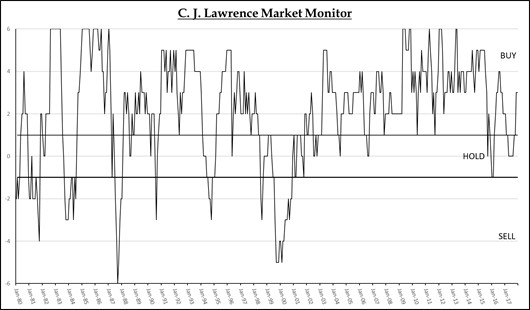- January 8, 2018
- Blog , The Portfolio Strategist - Terry Gardner
C.J. Lawrence Weekly – CJL Market Monitor Continues to Favor Stocks
As investment managers, we sleep with one eye open and the other on our Market Monitor. The C.J. Lawrence Market Monitor was created in the early 1980s to measure the attractiveness of the stock market. It calibrates the relative appeal of stocks versus fixed income and tests the internal technical health of the stock and bond markets. Over the Monitor’s 37-year history, it has been a useful asset allocation tool. While not developed as a timing model, the SELL signals generated prior to the stock market crash of 1987, and again in the period leading up to the bursting of the internet bubble in 2000, are two of the Market Monitor’s most notable measurements. The Market Monitor’s current reading is solidly in BUY territory at +3, on a scale of -6 to +6.
The Monitor consists of six components. Each is constructed to generate individual BUY, HOLD, and SELL signals. Two of the components are driven by equity fundamentals, two by the direction and rate of change in short and long interest rates, and two by technical and market breadth indicators. The interest rate signals were less useful post financial crisis, as rates fell to historically low levels and even small basis point changes had a meaningful rate of change impact. But the interest rate models are beginning to come back into balance as rates are normalized. Interestingly, in the December period, the Long Bond model generated a BUY signal, after several months in Neutral territory, as monthly average U.S. 30-Year Benchmark Treasury yields fell more than 10% below last year’s level. Normally, at the beginning of a rate tightening cycle, this component would be generating a negative signal.

C.J. Lawrence Market Monitor Chart – January 8, 2018
The Market Monitor’s bullish positioning is understandable given the recent improvement in equity fundamentals and cash flow yields on stocks, versus the still relatively paltry yields on fixed income instruments. As U.S. interest rates rise, as they are expected to do in the coming year, the risk-free rate on treasuries should become more attractive. But the pace at which the economy, and corporate profits, improves may continue to tilt the relative equation towards stocks. Asset allocators, increasingly worried about the veracity and length of the current bull market, may find comfort in the CJL Market Monitor’s stance. A breakdown in equity market technical metrics and breadth would certainly weaken its conviction, but the improving fundamental backdrop will likely keep the Market Monitor favoring stocks in 2018. We continue to overweight equities in balanced portfolios.
Full Disclosure: Nothing on this site should be considered advice, research or an invitation to buy or sell securities, refer to terms and conditions page for a full disclaimer.
